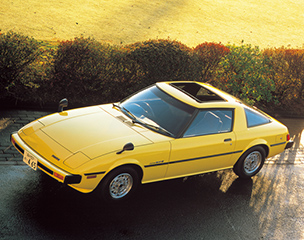Launched in September 1971, the Mazda Savanna was powered by the 10A rotary engine and came in two body styles: coupe and sedan. Named after the world's first steamboat and nuclear-powered ship, the Savanna conjured up a powerful image of big game roaming across the wild beauty of the African plains. In its first month alone, the Savanna sold 5,406 units. This result, and the fact that more than half of the trade-in vehicles in the first month were from other carmakers, makes it no surprise that the Savanna went on to have such a huge impact on the market.
In 1972, the Mazda Savanna was updated with the powerful 12A rotary engine. This version repeatedly raced and eventually beat Nissan's legendary Skyline GT-R, the undefeated Japanese touring car champion at the time.
In 1976, the Savanna showed its dominance by achieving its 100th victory in Japanese motor sports — the record for a single model car — and became a firm favorite among the younger generation.
In a climate of growing concern over environmental regulations, the Savanna matched outstanding running performance with environmental compatibility.
The Savanna AP was added to the series in 1973. Specially engineered to comply with the latest exhaust gas regulations, it used various means, including a thermal reactor* to reduce its emissions.
*Thermal Reactor: A system by which NOx generation is suppressed due to the relatively low maximum combustion temperature of the rotary engine, while the high average combustion temperature is used to reburn hydrocarbons and carbon monoxide in the exhaust.



